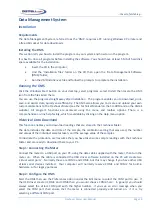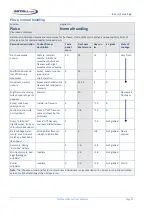
...the
art
of
distell
‐
ing...
Freshness
Meter
User
Manual
Page
17
The
extent
of
the
effect
varies
with
fat
content
and
temperature
during
storage
before
icing.
For
example,
lean
fish
held
for
8
hours
at
a
temperature
of
about
5°C
before
icing
will
generally
show
meter
readings
about
one
unit
lower
than
the
appropriate
organoleptic
chart
would
suggest.
With
fatty
fish
the
effect
can
be
up
to
twice
as
great
for
the
same
time
and
temperature
before
icing.
There
is
evidence
to
show
that
the
higher
initial
temperatures
can
easily
double
this
effect.
Mackerel
generally
behave
in
much
the
same
way
as
do
herring,
although
detailed
information
is
not
at
present
available.
The
organoleptic
charts
for
mackerel
(pages
and
42)
give
some
idea
of
readings
to
be
expected
from
carefully
handled
fish,
boxed
and
iced.
Although
less
is
known
of
the
relationship
between
objective
sensory
scores
and
meter
readings
than
for
white
fish,
it
is
believed
that
meter
readings
give
a
fair
indication
of
the
intrinsic
quality
of
unhandled,
boxed
fatty
fish,
irrespective
of
fat
content.
The
charts
on
pages
to
show
relationships
between
the
Fish
Freshness
Meter
readings
and
time
of
storage
in
ice
for
a
few
species
of
African
fish.
The
data
has
been
supplied
by
the
Tropical
Products
Institute,
London.
Effects
of
handling
and
processing
The
Fish
Freshness
Meter
measures
certain
properties
of
fish
muscle
and
skin
that
change
in
a
systematic
way
during
storage
in
the
wet
state.
Any
other
process
that
affects
the
structure
of
the
muscle
at
the
cellular
level
will
also
affect
the
measurements,
almost
invariably
to
lower
them.
Handling
is
an
important
factor.
A
common
method
of
handling
fish
in
Europe
is
to
store
it,
mixed
with
ice,
in
bulk
aboard
the
vessel,
then
unload
it
onto
the
quayside
and
sort
the
fish
into
containers.
The
pressure
it
is
subjected
to
in
the
hold,
the
handling
during
discharge,
and
the
sorting
process
tend
to
lower
the
meter
readings
when
compared
with
fish
that
have
been
stowed
carefully
in
boxes
with
ice
and
kept
undisturbed
until
measured.
The
difference
is
indicated
in
the
charts
in
the
section.
The
meter
can
also
be
used
to
grade
fillets.
For
skin
‐
on
fillets
make
the
measurements
on
the
skin
side
in
the
usual
way.
The
meter
measures
properties
of
both
skin
and
muscle,
but
it
can
still
be
used
with
skin
‐
off
fillets.
In
this
case
the
meter
should
be
applied
to
the
bone
side
of
the
fillet.
The
readings
though,
are
much
lower
than
for
whole
fish
or
skin
‐
on
fillets
of
equivalent
freshness.
Also
discrimination
in
fish
material
with
a
freshness
score
below
6
is
not
possible.
Typical
values
for
cod
are
shown
in
the
charts
beginning
on
page
The
quality
of
herring
and
mackerel
is
most
sensitive
to
handling,
and
in
each
case
this
is
reflected
by
the
readings
obtained
with
the
meter.
Even
careful
handling
of
the
fish
can
lower
the
instrument
readings
by
1
or
2
units.
Normal
commercial
handling
reduces
the
readings
still
further.
Effects
of
freezing
and
brining
Freezing
has
a
drastic
effect
on
the
cellular
constituents
of
muscle.
It
is
not
possible
to
determine
the
original
freshness
of
thawed
fish
since
meter
readings
are
invariably
in
the
range
of
0
–
3,
whatever
the
quality
before
freezing.
In
fact,
this
property
can
be
used
in
many
cases
to
determine
whether
fish
has
been
frozen
at
some
time
in
its
history.
If
the
sample,
judging
by
odour,
appearance
and
flavour
appears
to
be
fresh
i.e.
should
have
a
high
meter
score,
but
in
fact
gives
a
low
reading
then
there
are
grounds
for
suspecting
it
has
been
frozen
at
some
time.
Once
again
judgment
should
not
be
based
on
one
fish
only;
several
fish
should
be
examined.
Brining
also
lowers
the
reading
though
not
quite
as
much
as
freezing.
It
is
therefore
not
possible
to
check
the
freshness
of
brined
fish.






























